NOTES
CHANGES IN THIS ISSUE
Revisions
Revisions have been made to the balance of payments data as a result of incorporating the latest available data.
Change to a Calendar Year Basis
The estimates in this publication are presented on a calendar year basis. This change allows for better analysis in terms of international comparisons as data for most other countries are available on a calendar year basis.
Content Changes
Some changes to the content of this publication have been introduced. These changes include the addition of two countries to the list of countries separately identified. India, previously included in Asia n.e.s., and Norway, previously included in Europe n.e.s., are now separately identified in the tables.
Presentational Changes
This publication contains balance of payments components by country for the countries and country groups listed in Appendix. The alternative presentation of country by balance of payments components is available as Data Cubes on the ABS web site <https://www.abs.gov.au>. A breakdown of data on income credits and debits into compensation of employees and investment income can be obtained from the publication International Investment Position: Supplementary Country Statistics, 2003 (cat. no. 5352.0). Data are presented for the five financial years from 1999 to 2003 while annual time series of data from 1989-90 are available as Data Cubes on the ABS web site <https://www.abs.gov.au>.
ABOUT THE PUBLICATION
Balance of Payments, Australia: Supplementary Country Statistics (cat. no. 5338.0) presents statistics on Australia’s balance of payments by selected countries, supplementing the quarterly publication Balance of Payments and International Investment Position, Australia (cat. no. 5302.0).
This publication contains estimates for country dissections of Australia’s current and capital accounts. The statistics are consistent with those published in the March quarter 2004 issue of Balance of Payments and International Investment Position, Australia (cat. no. 5302.0). For related ABS products and services, see paragraphs 6-8 of the Explanatory Notes.
ROUNDING
Discrepancies may occur between totals in this publication and the same aggregates from other sources, and between sums of component items and totals due to rounding.
INQUIRIES
For further information about these and related statistics, contact the National Information and Referral Service on 1300 135 070 or Artur Andrysiak on Canberra (02) 6252 6792.
ANALYSIS OF RESULTS
CURRENT ACCOUNT
CURRENT ACCOUNT
The current account deficit for 2003, was $46.6 billion, an increase of $14.9 billion on the deficit of $31.7 billion in 2002. The current account deficit as a percentage of Australia’s gross domestic product (GDP) increased from 4% in 2002 to 6% in 2003.
The increase in the current account deficit was the net effect of the following:
- an increase of $13.4b in the net goods deficit to $23.2b
- an increase of $1.5b in the net income deficit to $23.0b
- an increase of $70m in the net services deficit to $359m.
The following graph shows major aggregates of the current account.
CURRENT ACCOUNT, MAJOR AGGREGATES
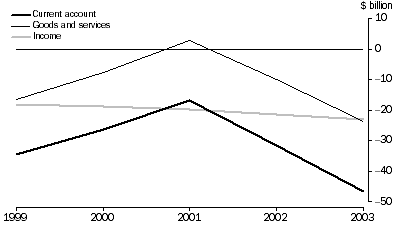
When analysed by country, Australia’s largest current account surpluses in 2003 were with:
- New Zealand, the surplus increased by $0.3b (5%) to $5.4b
- Republic of Korea, the surplus decreased by $1.9b (34%) to $3.6b
- India, the surplus increased by $0.9b (51%) to $2.7b
- Asia n.e.s., (see Appendix for countries included in this group), the surplus decreased by $2.3b (52%) to $2.2b
- Japan, the surplus decreased by $3.6b (63%) to $2.1b.
The largest current account deficits in 2003 were with:
- United States of America, the deficit decreased by $1.5b (9%) to $15.6b
- Germany, the deficit increased by $1.2b (18%) to $7.8b
- People’s Republic of China, the deficit increased by $0.7b (15%) to $5.2b
- France, the deficit increased by $1.1b (44%) to $3.6b
- International Capital Market (see Appendix for securities and loans included in this group), the deficit decreased by $0.1b (2%) to $3.0b.
GOODS
Australia’s largest net goods surpluses in 2003 were with:
- Japan, the surplus decreased by $3.1b (48%) to $3.4b
- Republic of Korea, the surplus decreased by $1.8b (36%) to $3.3b
- New Zealand, the surplus increased by $0.1b (3%) to $3.2b
- Asia n.e.s., the surplus decreased by $1.9b (42%) to $2.7b
- India, the surplus increased by $0.8b (53%) to $2.4b.
The largest net goods deficits in 2003 were with:
- United States of America, the deficit decreased by $0.9b (8%) to $11.1b
- Germany, the deficit increased by $1.0b (17%) to $6.8b
- People’s Republic of China, the deficit increased by $0.7b (16%) to $5.2b
- France, the deficit increased by $1.0b (51%) to $2.9b
- Italy, the deficit increased by $0.8b (45%) to $2.6b.
GOODS CREDITS (EXPORTS)
The main countries of destination for exports of goods in 2003 were:
- Japan, a decrease of $2.5b (11%) to $19.8b or 18% of total goods credits
- United States of America, a decrease of $1.9b (17%) to $9.5b or 9% of total goods credits
- People’s Republic of China, an increase of $0.7b (8%) to $9.2b or 8% of total goods credits
- New Zealand, an increase of $0.2b (3%) to $8.2b or 8% of total goods credits
- Republic of Korea, a decrease of $1.9b (19%) to $8.2b or 8% of total goods credits.
The following graph shows the percentage contribution to total goods credits by the main destination countries.
GOODS CREDITS, MAIN DESTINATION COUNTRIES
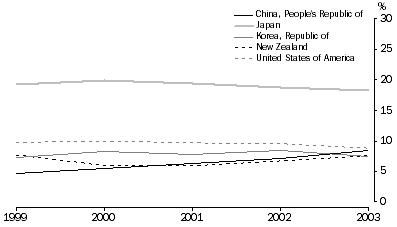
GOODS DEBITS (IMPORTS)
The main sources for imports of goods in 2003 were:
- United States of America, a decrease of $2.8b (12%) to $20.6b or 16% of total goods debits
- Japan, an increase of $0.5b (3%) to $16.5b or 13% of total goods debits
- People’s Republic of China, an increase of $1.4b (11%) to $14.4b or 11% of total goods debits
- Germany, an increase of $0.7b (9%) to $8.1b or 6% of total goods debits
- United Kingdom, a decrease of $0.4b (7%) to $5.5b or 4% of total goods debits.
The following graph shows the percentage contribution to total goods debits by the main source countries.
GOODS DEBITS, MAIN SOURCE COUNTRIES
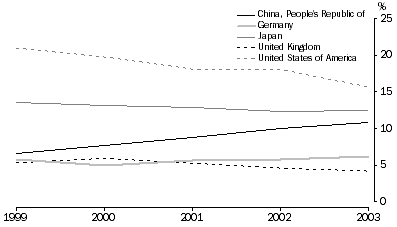
SERVICES CREDITS (EXPORTS)
The main countries to which Australia provided services in 2003 were:
- United States of America, a marginal increase (1%) to $4.8b or 15% of total services credits
- United Kingdom, an increase of $0.1b (1%) to $3.8b or 12% of total services credits
- Japan, a decrease of $0.4b (12%) to $3.2b or 10% of total services credits
- New Zealand, an increase of $0.2b (8%) to $2.4b or 7% of total services credits
- Singapore, a decrease of $0.2b (10%) to $2.1b or 6% of total services credits.
The following graph shows the percentage contribution to total services credits by the main destination countries.
SERVICES CREDITS, MAIN DESTINATION COUNTRIES
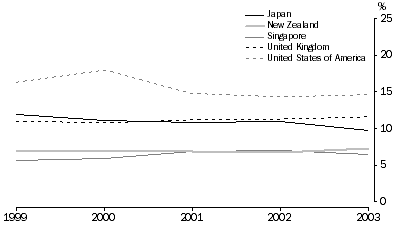
SERVICES DEBITS (IMPORTS)
The main countries which provided services to Australia in 2003 were:
- United States of America, an increase of $0.1b (1%) to $6.2b or 19% of total services debits
- United Kingdom, a marginal increase to $3.7b or 11% of total services debits
- Singapore, a decrease of $0.3b (10%) to $2.4b or 7% of total services debits
- Japan, an increase of $0.1b (3%) to $1.9b or 6% of total services debits
- Asia n.e.s., an increase of $0.4b (29%) to $1.8b or 5% of total services debits.
The following graph shows the percentage contribution to total services debits by the main source countries.
SERVICES DEBITS, MAIN SOURCE COUNTRIES
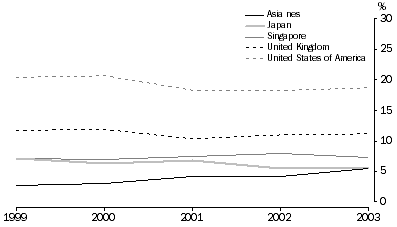
 Print Page
Print Page
 Print All
Print All